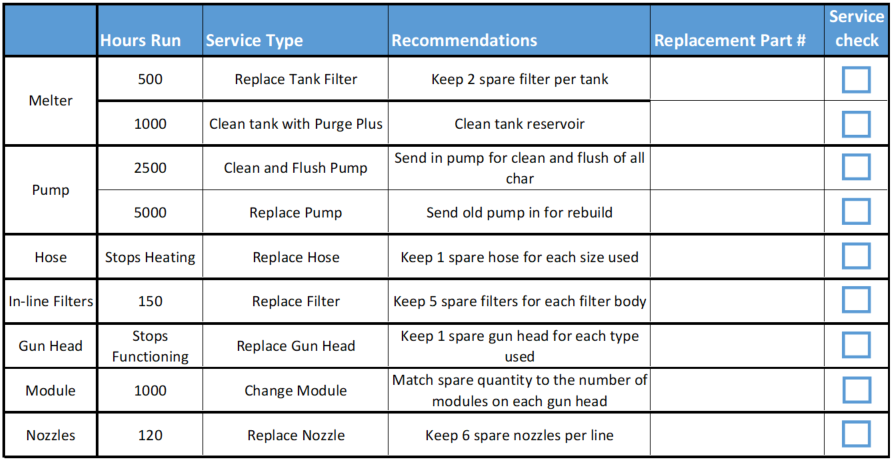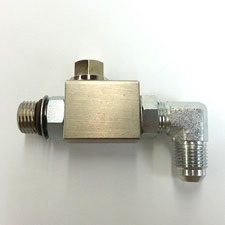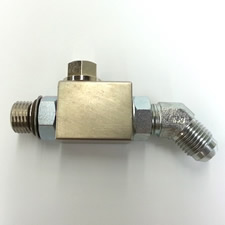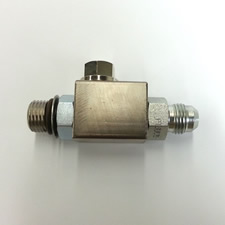The Importance of Using Aluminum for Manifolds
Universal Systems SE manufactures high quality hot melt application manifolds that will work with most all hot melt application systems. We understand the importance of durability, consistency and effectiveness in packaging manufacturing, which is why we use 6061T aluminum when making all of our manifolds.
What is a Manifold?
When evaluating what you need for your hot melt application system, it is important to understand each item that makes up the application gun. The manifold is the aluminum gun body, that houses the heater & sensor, and is where the modules mount.
Why do we use Aluminum?
Aluminum is used on all of our hot melt applicator manifolds because it is an excellent conductor of heat and dissipates heat very efficiently. Aluminum also has a very high strength to weight ratio, meaning that although it is light-weight, it is extremely strong. Its strength is what allows for peak performance during the rigorous packaging process. It is also non-toxic, cannot burn and is easily recyclable.
Why do we use 6061T Aluminum?
All of Universal System’s ProBilt™ manifolds are manufactured using 6061T aluminum. 6061T aluminum is aviation aluminum and used for the building of all jet aircrafts. This will extend the lifespan and durability of the manifold and increase it’s on the floor performance.
For more information on how to buy a hot melt gun applicator or manifold, please reach out to sales@ussefl.com or call (561) 272-5442 today!
Zero Cavity Modules and What They Are Used For
There are several different set ups available for your hot melt application. That’s because not all industries use glue application for the same reason. The most common form of hot glue application is standard case packers for mass production high speed packaging. Typically, those lines use standard H200 modules. However, glue application is used to seal other, more specific products. For example, swirl pattern modules are used for glue application on feminine hygiene products, diapers and also for sealing air filters. This blog is going to specifically explain zero cavity modules and what industries use them and why.
Zero cavity modules have a very specific look, with a nozzle head attachment rather than a screw on nozzle. They also come with an E-Z Micro Adjust attachment to manage precision glue application. This nozzle & micro-adjust feature is custom manufactured for precise glue placement on smaller boxes, such as crayon boxes or pharmaceutical products. This unique technology allows for line operators to place a small amount of glue on a small, predetermined location without creating any stringing. Typically, because of this precise requirement, most zero cavity modules are made with either a .008 or a .012 diameter orifice, so that there can never be too much glue applied.
Because zero cavities have a matched piston needle and seat, when they finally wear out, most manufacturers require customers to replace the entire module. Universal Systems does not. We manufacture a rebuild kit specifically for zero cavity modules for a fraction of the price of replacing an entire module. Check out our rebuild kits here: https://www.ussefl.com/products/hot-melt-modules/module-rebuild-kits/.
Not many hot melt application manufacturers offer zero-cavity modules. Luckily, here at Universal Systems we have been manufacturing this specific module for over 25 years. If you would like to learn more about zero cavity modules or get a price quote, please reach out to sales@ussefl.com or call (561) 272-5442.
How to Keep Old Melters Operable
Do you have an old series 2300 or 3000 melter that you are still using but need to find parts for? If you do, your packaging line is running a melter that is 15 – 20 years old. That means that your line operators are maintaining your packaging lines well and spending money in the right areas to keep efficiency and durability a priority. With that said, not everything will last forever. While you can probably keep the control panels of the 2300 or 3000 melter, some of the internal and exterior parts may need to be replaced. The reality is that Nordson® no longer supports these tanks. However, Universal Systems SE does. Universal Systems SE manufactures pumps, filters, hoses, guns, modules and nozzles that are compatible with your old melters.
Pneumatic Pumps
The first thing to go on your old melter, will most likely be your pump. Once that stops working, it will become very clear that your OEM no longer manufactures replacements for that part. So now you have to decide between purchasing a new melter from them for $15,000+, or trying to replace your pump. Universal Systems SE manufactures new series 2300 and 3000 pumps for a fraction of the price of a new Nordson® melter. Check out our full line of pneumatic pumps.
Actuator
If you have experience with rebuilding pumps, Universal Systems also manufactures the pump shifter and fork for the ProBilt™ series 2300 and 3000 pumps. This is another item you will not be able to find with the OEM because it has been discontinued.
Tank Filters
Since your series 2300 or 3000 melters have been operating on the line for so many years, your line operators probably change out the tank filters frequently. As the years have gone by, you may find it more difficult to find reasonably priced, or readily available tank filters. Universal Systems manufactures the tank filter assemblies, filter cores and filter screens to fit your series 2300 and 3000 melters.
Same Footprint
If you have gone through all of the steps to fix the problem with your old melter and find out that it is the control panel, which has been discontinued, Universal Systems SE has a solution for that as well. Our ProBilt™ melters have the same footprint and dimensions as your current series 2300 or 3000 melter. That means that your NEW ProBilt™ melter, that comes with a 10-year heater warranty, will fit right in where your old melter comes out.
For more information or to contact a technician that can help you troubleshoot issues with your old melter, call (561) 272-5442 or email sales@ussefl.com.
Managing Your Glue Usage in Packaging
Hot melt adhesive is not cheap and you may notice that the prices are only going up. What purchasing agents might not know, is that a lot of packaging lines are using more glue than is actually needed. There are a few simple ways to manage your actual glue usage and help cut costs to manage your budget.
Nozzle Diameter
The first step in managing your glue usage, is knowing the diameter nozzle tip you are using in your packaging lines, and understanding why you are purchasing that size. A lot of times, our sales reps will get calls from customers that want to buy larger size nozzle tips because their line operators are saying there is not enough glue being released on the cartons. Obviously, as you increase your nozzle tip diameter, the more glue you are going to use overall and increase your yearly costs for adhesive. This can also cause several other issues, such as potential sealing issues if the hot adhesive does not have enough time to dry as it moves along the cartoner. If your line operators are asking for larger diameter nozzles, question them as to why.
Evaluate Set-up
If your line operators are stating that the glue is not keeping the packaging closed, which is why they need larger nozzles, evaluate your setup. Check the distance your gun applicator is to your carton and at what temperature you are heating your adhesive. If the adhesive is not hot enough and your gun is too far away from the application site, the adhesive could be cooling before it even hits the carton which is why it is not creating a tight seal. Simply increasing your heating temperature or moving your gun applicator closer to the end application site could solve this issue. You could also be putting down too much glue already. If you have a high-speed packaging line, and put down too much glue, the speed will not allow time for the large amount of glue to dry.
Change Your Filters
Another simple solution to managing your glue usage, is to check both your tank and gun filters. If your nozzles are clogging frequently, causing the line operators to buy larger diameter nozzles, they may be clogging due to char. Char is a typical occurrence in hot melt packaging, but the transfer of most char can be prevented by regularly changing your tank and gun filters. These filters will extend the life of both your modules and nozzles.
For more information or tips on how to increase your packaging line efficiency and lower your costs, call a Universal Systems representative at (561) 272-5442 or email us at sales@ussefl.com.
Simplify with the AccuScan™ Control Panel
Universal Systems SE manufactures a premiere line of hot melt adhesive systems. Our ProBilt™ line of tanks all come with our patented AccuScan™ Control Panel. The AccuScan™ Control Panel is exclusive to ProBilt™ machines and is easy for any line operator to use.
One of the most common feedback points we hear from customers is that they like simplified operational equipment. Usually line operators are understaffed and overworked. Simplifying how they use our equipment is a big selling point and the AccScan™ Control Panel is a great example of that.
Universal Systems SE developed our AccuScan™ Control Panel to simplify the operation of our adhesive melter systems. The main control screen lists the operational settings for up to 4 hoses and guns and the main tank. You can filter through these sections by pressing the Zone button. Once you choose the zone you wish to set the temperature for, press and hold the Set button. Then, using the up arrow, the digital screen will show the temperature setting increase until you reach your desired temperature setting. Once the tank or hose zones are set to desired temperatures, release the Set button. We also offer a Set Back button on the main screen. The Set Back feature puts the machine in an idle state, heating only to 165 degrees.
For further step by step instructions, we have put a video on our Universal Systems SE YouTube channel. Please check it out at https://youtu.be/QhSCXZs-8wY.
For any further instructions or information about our AccuScan™ Control Panel please call (561) 272-5442 or email sales@ussefl.com.
Melt Rate vs. Pump Rate
When purchasing a hot melt adhesive system, it is important to know your desired melt rate and pump rate. It is also important to understand the difference.
All Universal Systems SE ProBilt™ tanks are equipped with a 14:1 ratio pneumatic pump assembly. Pneumatic pumps are most common and have a maximum pump rate of 75 lbs. per hour. No matter what the tank capacity is, whether it is 12 lb., 15 ob., or 20 lb., the pump will max out at 75 lbs. If you need to pump more adhesive then that per hour, you will need to transition to a gear pump system with a larger tank capacity.
The melt rate is the rate at which the tank will melt the adhesive you put into the reservoir. This is where the tank capacity comes into play. Before moving forward with any hot melt adhesive system, first you need to understand how many pounds you need to melt per hour. The melt rate is dependent on how many hoses and gun applicators you are running and how many boxes are sealed per minute on your packaging line. The most common tank capacity is the 20 lb. (10 Liter) ProBilt™ 20, with a melt rate of 23 lbs. per hour. If you are only running one line with one hose and gun applicator, then you may only need the 15 lb. (7 Liter) Probilt™ 15 which melts 18 lbs. per hour.
A common misconception is that the on-demand autofill system, the ProBilt™ Phoenix, will have a larger melt rate and pump rate. That is incorrect. The tank capacity on any auto fill system is the same as a regular tank such as the ProBilt™ 20. However, the advantage to the auto fill is that the line operators will not have to watch the adhesive level in the tank as closely. The vacuum system connected to the tank will sense when the adhesive level is low and automatically fill the tank. This helps eliminate dry running and pumps will last longer. However, the pump rate on this system will still max out at 75 lbs. per hour.
For additional information about melt rate and pump rate on all of our ProBilt™ tanks, please call (561) 272-5442 or email sales@ussefl.com.
The Importance of Utilizing Cross-Referencing
The packaging industry is entering the time of year when budgets are getting tight, but replacement parts are still needed. Universal Systems SE will cross-reference any of our competitor item numbers and get you high quality replacements. Cross-referencing Nordson item numbers to Universal Systems SE item numbers will help to lower your cost and keep your packaging lines running longer!
You will also notice that our competitors change their part number often. This is why we offer the search bar on our website for any cross-reference numbers you might have. Some of the most common cross references are listed below. If you purchase any of the parts listed on a regular basis, please feel free to call us today! We guarantee that all of our products are quality control tested before leaving our facility and we stand by all of our products with strong warranties.
Adhesive Systems:
P10, 1022234, 1022235, 276881, 276882, 276883, 276884, 276885, 276886, 276033, 276034, 238310, 243666, 168204, 166535 à ALL of these item numbers match USSE # D100-644
Heated Hoses:
4 Ft. Hose:
107288, 129556, 100120, 274791, 276151 –> 4104
6 Ft. Hose:
107286, 129557, 100121, 274792, 276152 –> 4106
8 Ft. Hose:
107287, 129559, 100122, 274793, 276153 –> 4108
10 Ft. Hose:
107289, 129561, 100123, 274794, 276154 –> 4110
12 Ft. Hose:
107310, 129562, 100124, 274795, 276155 –> 4112
16 Ft. Hose:
104008, 129564, 100125, 274796, 276156 –> 4116
20 Ft. Hose:
223838, 223836 –> 4120
24 Ft. Hose:
129565, 100832, 100126, 274797 –> 4124
Applicator Guns:
H200 1 Module AO/AC
8503717, 8505756, 8505768 –> 39105
H200 1 Module (AO/SC)
274596, 224939, 8503591, 8503686 –> 39107
Modules:
H200 (AO/AC)
1052927 –> 29215
H200 (AO/SC)
272282, 276119, 326583, 331979, 1048115, 2210, 2219, 2400, 2410 –> 29219
For any other questions on cross-referencing, please call (561) 272-5442 or email sales@ussefl.com.
In-Line Gun Filters
There are a couple different types of filters that you need to change out regularly on your adhesive melter system. One is a tank filter, which we describe in a previous article: The Importance of Tank Filters. The second, is the in-line gun filter. This is the filter that goes between the hot melt gun applicator and heated hose. This is the last line of defense against char being transferred through the module and potentially clogging the nozzle.
There are a three different in-line filter assemblies that are available for your hot melt system: Straight, 45 Degree & 90 Degree. The first is a filter assembly with a straight connector from the gun to the hose. This straight fitting is used when guns line up directly with hoses, typically applying the glue straight out to onto the boxes. The other two filter assemblies offer a 45 degree and 90 degree fitting that allows you to connect the hose to the gun at an angle. These filter assemblies are mostly used on setups where the applicator guns are either above or below the packaging line.
Each filter assembly is available with 50 mesh, 100 mesh and 200 mesh filters. The replacement filters are sold separately in packs of 5 for easy installation so that you do not need to switch out the entire assembly. The filter is easily screwed into the top of the filter body as seen below. Please make sure that you lubricate the o-rings before installation to help you for future filter changes.
For more information on which in-line filter assembly is best for you, please call (561) 272-5442 or email sales@ussefl.com.
Line Operators: The First Line of Defense
Understanding hot melt tank systems is no simple task. It usually takes years of experience to learn how to effectively manage adhesive systems and keep your packaging line running efficiently and effectively. Universal Systems SE understands that new line operators come into work and might need help learning which items to replace and how to replace them the correct way. That is why we offer technical support to all of our ProBilt™ customers!
There are several maintenance tasks that we recommend be completed on a regular basis to keep your adhesive system free of char and debris, which is the number one culprit in bringing down a line. Below is an easy maintenance checklist that each line operator should have in hand.

We recommend that you print this checklist out and give it to every shift that operates the packaging line. Keep in mind that changing out items such as gun heads, modules, filters and pumps all require you to clear the old lines and remove the air pressure before re-installation. Releasing the air pressure and removing all old adhesive will ensure that all seals stay intact and reduces the char transferred from the old to the new parts.
If you need help changing out parts or have questions about which items need to be changed regularly, please call (561) 272-5442 or email sales@ussefl.com.
Troubleshooting Tips for Packaging Line Issues
Since Universal Systems SE offers technical support for all of our customers, we get several calls per day with all different kinds of technical issues that line operators experience. Because many packaging lines run 24/7, without regular maintenance of key products there will always be issues after a certain period of time. As always, we recommend changing your filters, nozzles and modules when needed to eliminate any potential issues. However, there may be other parts on your packaging lines causing these issues.
For example, if you are experiencing a dripping or not fully functional module, it is most likely not an issue with the module itself. Especially since all products go through a vigorous quality control process before leaving our facility. Because the modules are air open and spring close, there are a few items to check before switching out the module. First, Universal Systems SE recommends that you check the solenoid valve. The solenoid valve is the air supply that runs into the applicator gun and fires the glue onto the box. If the solenoid valve fails, it will not generate air power to fully open the module. If the solenoid valve is weak, it will not fully exhaust all of the air out of the module, and the module piston will not seat properly, causing a drip. Another potential issue could be that char or debris has been transferred from the tank into the gun and has gotten stuck in the spring close. This piece of char, no matter how small it could be, can limit the spring from fully closing causing “dripping”. Spring tension on the gun module being set too low could also cause “dripping”, so make sure you try to adjust that before switching out modules. Finally, if the line operator has not gone through the correct steps to change out the module, the module could be compromised. The line operator needs to make sure that they lower the air pressure used on the tank before switching modules. If they do not, they could potentially send glue into the air chamber of the gun when removing the old module.
Another common technical issue is that the heated hoses are either not heating or not heating to the correct temperature. The first step is to check and ensure that the hose zone is not set to “off”. If it is, turn the hose zone to “on”. Then, you should check to make sure all connectors are securely tightened and the controller settings are correct. If all of those are working, you next need to check the ohms reading on the hose heater and hose RTD, and all of the board fuses. A USSE technical support representative can walk you through this check process and help identify the real issue.
For more information or if you need technical support not mentioned, please call (561) 272-5442 or email sales@ussefl.com





